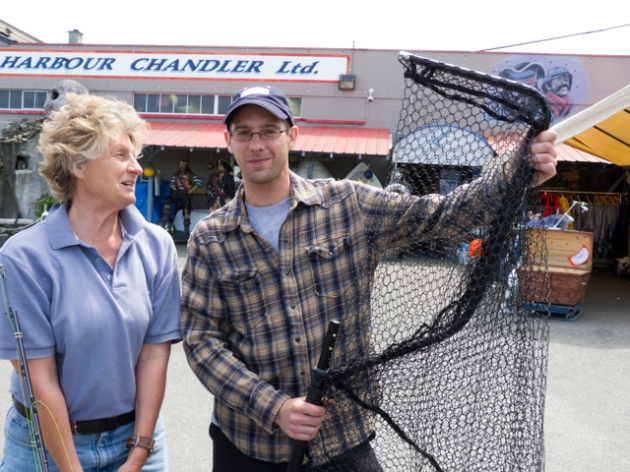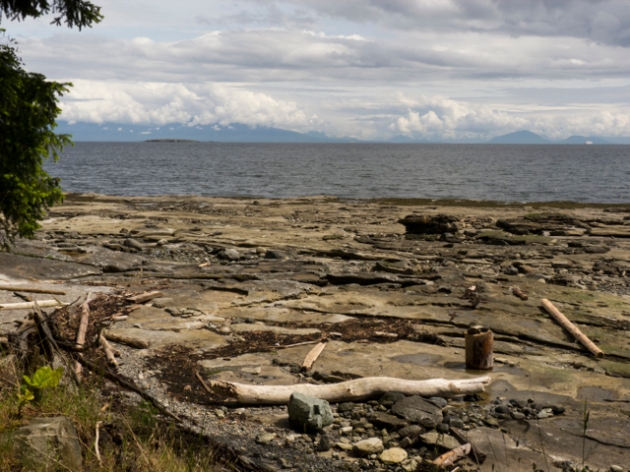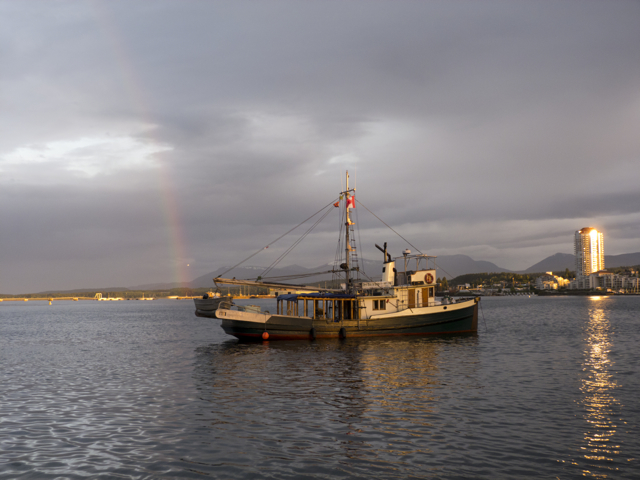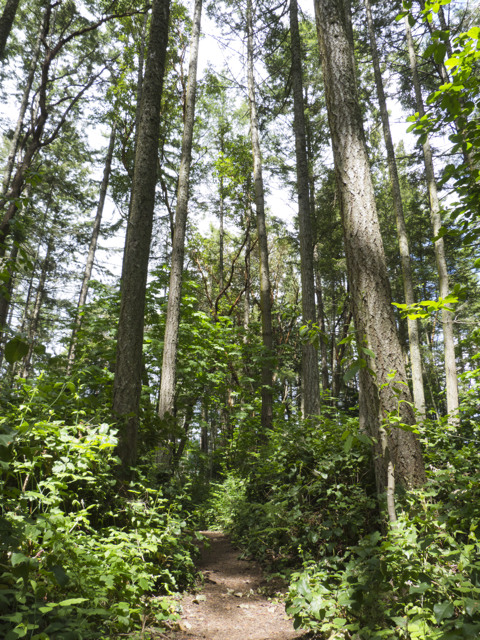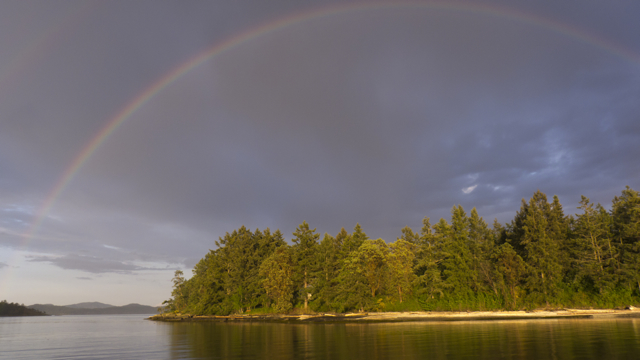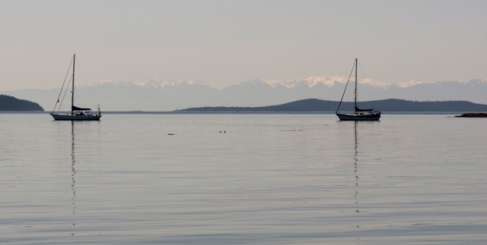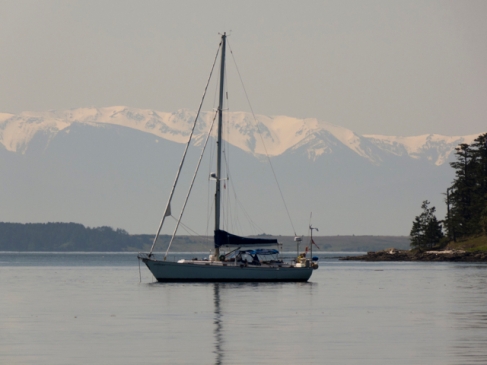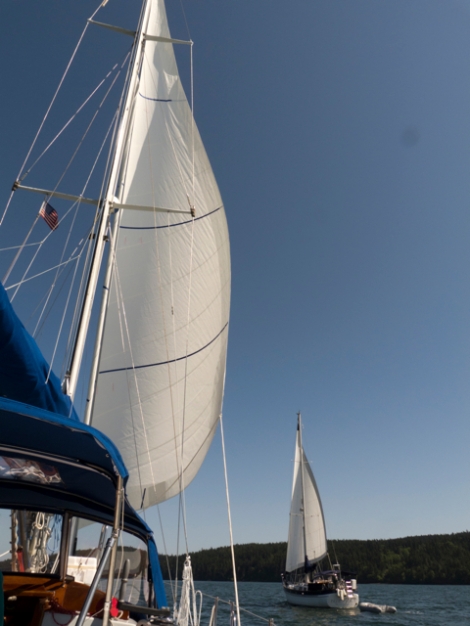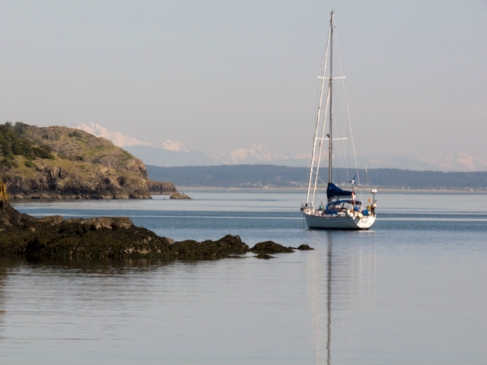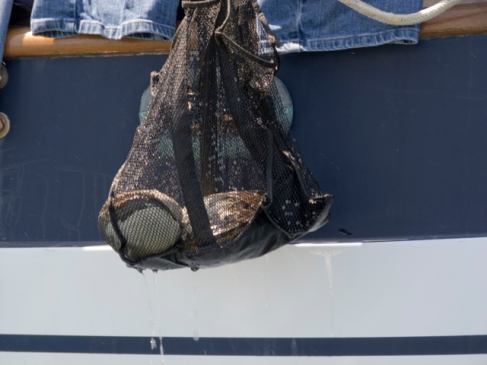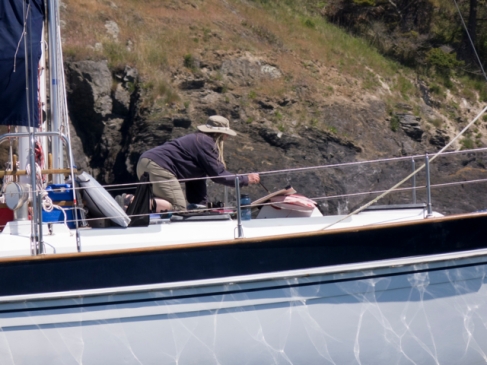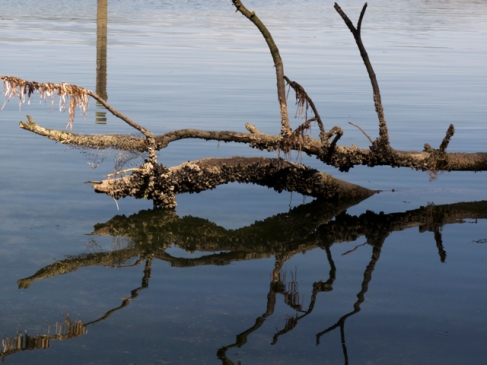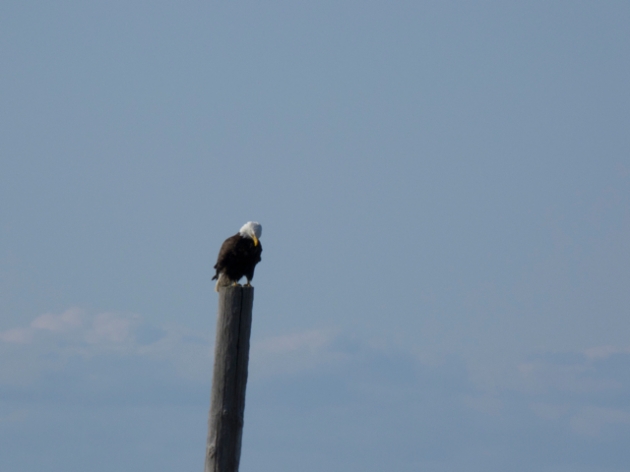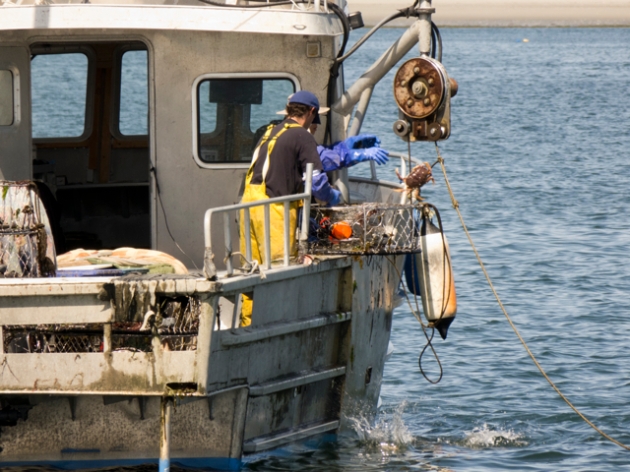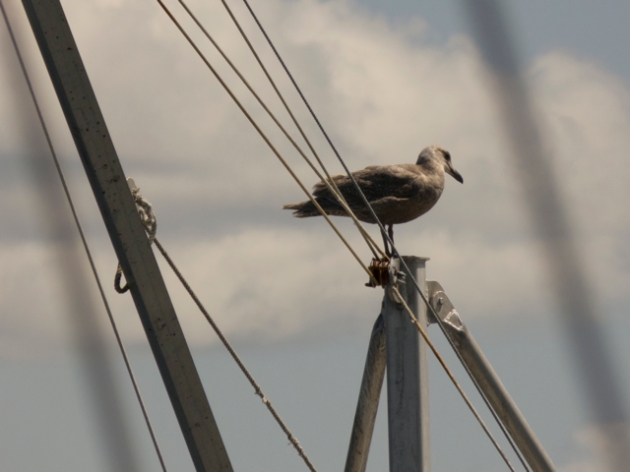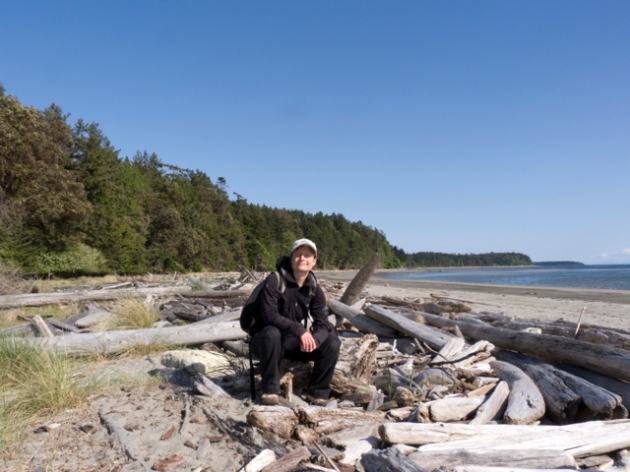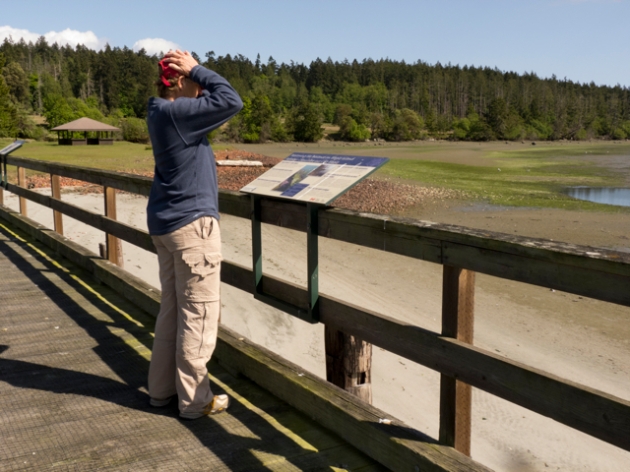
Karin on the deck of a damaged Quoddy’s Run on the Dockwise ship in Nanaimo
A blue water cruising vessel is like a house that you shake up and down and immerse in salt water. Things break and wear out under such stresses. A sailing vessel built in 1976, and sailed hard part of the time in the tropics, Quoddy’s Run had aged to the point where she required not simply a facelift, but some joint replacements. When we purchased her in 2003, we knew that she was going to require some work, but we decided to go sailing rather than spending–at that moment–the years and money necessary to repair her fully.

A damaged Quoddy’s Run aboard the Dockwise ship
When we began to think about bringing Quoddy’s Run to British Columbia, we knew that we were going to have to address a number of issues apart from paying customs duty and taxes. We even considered selling her to avoid such extravagances, but when we showed her to a prospective customer in Mexico, we balked. We love our boat and our hearts would not let us part with her, although it may have been the economically rational thing to do. “Oh you’d just go out and get another boat,” said Karin (this is probably true), “and we already know what we’re in for with this one.” So we booked passage for Quoddy’s Run aboard the yacht transporter, Dockwise, and awaited her arrival in Nanaimo last May, 2011. We had decided not to sail her further north precisely because her rig needed going over and possibly repair.
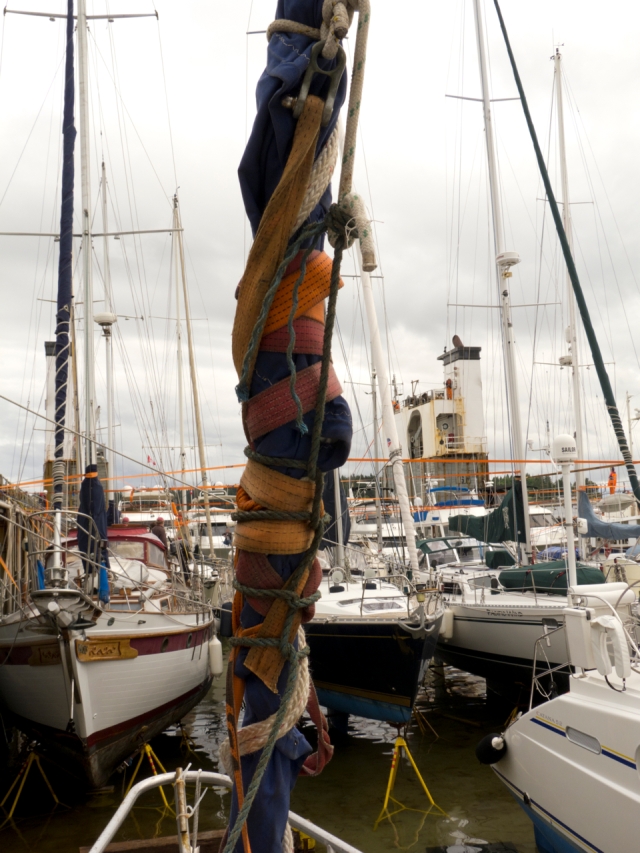
Forestay and ripped sail all tied up
As you may have heard, while aboard the Dockwise ship, during a night storm that came at the vessel on the forward starboard quarter, a stay gave way on Quoddy’s Run. The thrashing of the staysail furler about the deck, before it was discovered and lashed down by the crew, destroyed much of QR’s rigging and sails forward of the mast. Crestfallen, we motored Quoddy’s Run off the ship and around to Blackline Marine Repair at Canoe Cove on Vancouver Island, the outfit suggested by the shipping company’s insurer’s surveyor. Thus began stage one of QR’s refit, some of it covered by insurance. We like to think of the damage on the ship as a big red finger pointing down at the boat saying, “Fix this now, and this too, and better check that while you’re at it.” And so we did.

Damaged furler and staysail

Stout replacement for the bit that broke (for want of a nail…)
THE RIG

Will fixing things at the top of the mast at Canoe Cove
Blackline is first and foremost a rigging and stainless steel fabrication company. Before we set off for our summer sail last year (2011), they replaced all of the stays (those wires that hold the mast up), and the chain-plates—stainless steel straps bolted to the knees of the hull that hold the stays down to the deck. Jeff, Brent and Will, all expert riggers, clambered up the mast, inspected all the fastenings, reattached the new wires and chain plates, sometimes making them even more skookum than before, because that is what they knew was called for. It was a pleasure, not to mention of great reassurance, to watch such consummate professionals at their work.

New stainless steel pulpit gleams in the sun
Their stainless steel technicians, who really should be called artists, fabricated a new pulpit (the bit that goes around the bow or front of the boat), stem chain-plate, stanchions and boarding ladder for the boat. They even polished the nuts, making their work sparkle like those brilliant hubcaps on long haul transports.
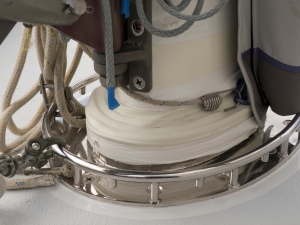
Mast collar at the deck

Mast collar belowdecks
This winter the mast was un-stepped in order to replace the fastenings and sheaves at the mast head, to repair the base of the mast where it was slightly corroded, to rebuild the mast step at the base of the hull, and to fashion a new mast collar where the mast goes through the deck. This collar is a piece of jewelry, a necklace so to speak, of incredible workmanship. We had the design modified somewhat to accommodate blocks on deck should we ever get old and rickety enough (right now of course we don’t really believe that will ever happen) to require all halyards and reefing lines to be lead aft to the cockpit. Currently, Marike finds it an easy step and a half to the mast from the center cockpit to raise, lower, and shorten sail in all conditions.

Will again, working on the rigging
Much of the running rigging was also upgraded: several new halyards, the non-stretch new hi-tech kind. A new Harken furler, and new furling lines. Even the boom vang—a gold star to whoever knows what that is–was rebuilt.

Vern, Seamus and Jeff hold the base of the mast as the crane lifts
Sometimes, in the past, our mast pumped; indeed, we’d nearly lost the rig when the forward chain plate bolt gave way in Panama a few years ago. But since Blackline has had a go at it, the rig is as solid as a BC red cedar, not to mention tuned to perfection by Jeff, a retired Olympic sailboat racer. Yes, it’s true: not only are musical instruments tuned, but sailing rigs as well, and with similar results—the harmonies of their parts are pleasing to the senses.

Quoddy’s Run–and new sails–wing on wing
THE SAILS
When we purchased Quoddy’s Run in 2003 her sails, apart form a relatively new staysail, were already a disaster. Her large foresail, a Genoa, was blown out like an old bag, her Yankee was stiff but tired, and worst of all, her mainsail was more like a heeling over mechanism than a forward driving force. But the boat continued to sail fairly well in moderate to heavy winds provided we reefed the main early and deep – a testimony to the Kelly Peterson’s balance and design if anything. In light winds, however, our 38,000 lbs would lumber along so slowly we usually ended up using the old iron sail, our engine.
Shortly before loading the boat on Dockwise, we had procured a secondhand set of sails for Quoddy’s Run that we thought would fit her. That’s the problem with having a boat off-shore, you cannot get the sailmaker to her for measurements. The thrashing she took on Dockwise destroyed both her staysail and her Yankee, and destroyed her mainsail cover as well. Stuart Dahlgren, owner of UK Halsey Sails in Sidney, paid us a visit to measure for and persuade us that UK’s hi-tech computerized international design team was worth choosing over more locally based sail-makers. He gave us good deal on a new main if we gave him the contract for the foresails. And there was this thing called a lazy cradle mainsail cover which combined lazy jacks (vertical strings that keep your lowered sail from falling all over the place) with a cover that remained on the boom at all times. Anything lazy to do with the mainsail Marike was up for–so we ordered that as well. Do not believe all promotional adjectives always. (That lazy cradle is not so lazy if you let the sail down to quickly. If you let it down slowly however, and train it carefully in what Stuart calls “Dacron obedience school” it’s pretty grand.) In three weeks, we would have a completely new set of top-drawer, blue water finish, off-shore sails for Quoddy’s Run. What a luxury! All the more so because the used main we had procured was five feet too short at the luff. Ooops!

Quoddy’s Run, sun and spinnaker
Still, the two spinnakers and large Genoa did fit and proved almost new. Quoddy’s Run now has a downwind sailing capacity dignified of a vessel plying the light winds of BC’s coastal waters not to mention a potential Pacific passage maker running the Tradewinds. What is more, the spi’s are brightly coloured!
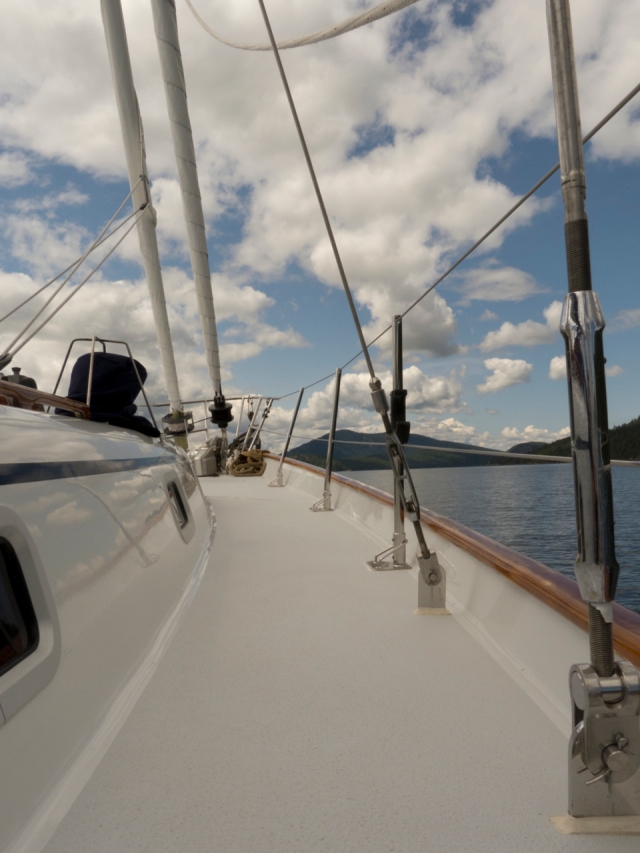
A new deck so gleaming it reflects the clouds
THE DECK!
Now, what about those soft spots on the deck, and what about all of the leaks through deck fittings, port-lights, and hatches? We knew they were there, even when we bought Quoddy’s Run but since for a number of years we kept her in the Sea of Cortez, laying her up over the summer in the Sonora dessert with full deck covers, we delayed addressing them. Every year Marike would stomp around on the deck feeling for cavities with her feet; they were spreading. Keith, the composites man at Blackline, examined QR’s topsides and declared the situation grave; the cure draconian.
Quoddy’s Run would have to have her mast unstopped, to be rolled into a shed, have her decks cut open, the top layer of fiberglass peeled, her portlights and hatches removed, the rotten mahogany laminate core removed, new foam core inserted and the surface reglassed and repainted. We hesitated. We tried to imagine alternative solutions: “let’s just drill holes and squirt epoxy into the old core.” But there was nothing left for the epoxy to adhere to, and we’d still have to repaint in any case. The estimate made us gulp. Finally Keith came up with the line that made us decide to do these favours for our vessel: “Somebody has to love this boat enough to fix her properly.” Quoddy’s Run had carried us for thousands of miles safely, swiftly, and comfortably. Clearly, that somebody who loved her enough was us.
Quoddy’s Run was in the shed from September 2011 to the end of April 2012. As Med–short for Diomedes, Blackline’s brilliant fiberglass artist–stripped her down, Blackline sent photos of more and more vast spreads of rot. Around the port-lights, up the bulwarks, even around the old teak hatches. Med carved, and carved, then replaced the foam, and re-glassed. We chose to install new Lewmar port-lights and hatches. (We would have liked to keep the classic old ones but that would have involved far more work and cost.) The new ones are far easier to open and close and let in much more light. On the inside, where the old water stains once were, we now have clean marine white surfaces. The deck and foc’s’l are repainted white with light grey non-skid. Any extraneous teak has been removed. All deck fittings have been rebedded. New stanchion bases, stanchions, and lifelines were fitted–now people can actually lean on them without fear they will give way to rust at any moment. No more points of entry for water–we hope, anyway. We’ve been through some rain storms and gusty winds now, and so far, so good.
Quoddy’s Run glistens like a new boat; her structure is solid; her below-decks comfortable, light and dry.

Looking up through a new hatch–and the rain–at the mast
THE ELECTRONICS
When Marike learned to sail, navigation was done by dead reckoning, something we still like to do in case of electronic failures. Previously we relied on a GPS system from the early 1990s; one day that unit just packed it in, leaving the spare below decks to rely on. Our electronic chart plotting system was run through our computer, also below decks, as was our vintage radar screen. That meant that in a tight spot, Karin was always having to pop down below decks to check the screens then pop up to relay the information to a short-handed skipper. That works in waters of little fog and fewer reefs. BC is not one of those places.
So we splurged and installed in the cockpit a spanking new Lowrance GPS, chart plotter, depth sounder, and broadband radar system. All the information we need is in the cockpit and interfaced. This allows us both to be in the cockpit handling sails and helming as we wind our way through channels and currents. What a relief! We can also take photos of the screen, witness to wild moments of white water keel-boat surfacing at over 9 knots through waters like the Dodd’s Narrows.
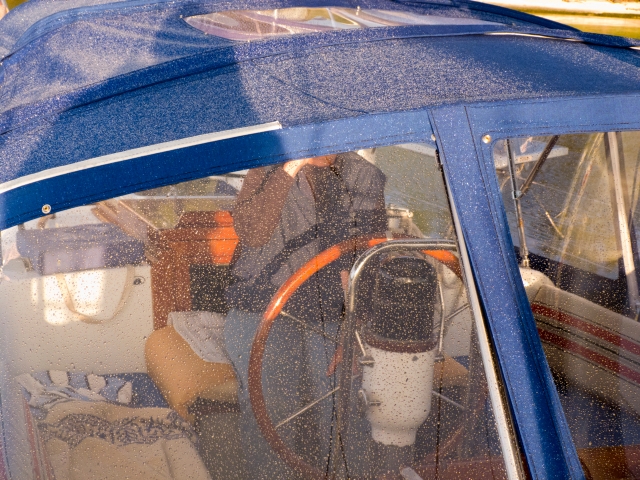
Dry inside, wet outside–as it should be
THE CANVAS
For the past several years, our main concern for shelter in QR’s cockpit has been for shade from the blistering tropical sun, although our dodger did keep us warm during night sails and in blistering northerlies. Last spring when we arrived in Nanaimo it was raining–through all of our canvas coverings. We were soaked. The UV rays had totally eaten away at our dodger and bimini. We’d had them re-stitched umpteen times. The canvas man we had scheduled in BC to redo the canvas took our deposit and never showed up. Finally we met Alan at Watershed Canvas at Canoe Cove whose work looked very professional. We placed our order a year ahead of time for a completely enclosed cockpit–a sort of pilot house made of canvas and Lexan. Originally we thought that Alan would have it all completed when we arrived. We’ve since discovered his process of patterning. The dodger and bimini were made. but then once the rig was re-stepped he had to measure for the connector pieces. We had to be there to tell him how we wanted them. How large a window overhead; where to put the openings for sheets and lines to run through; how far aft the base of aft curtains, etc.

Looking out through the raindrops, through the Lexan
Witnessing Alan make the patterns was a thrill in itself. Karin likened him to the pattern-makers at NSCAD, though where they use paper or fabric, Alan uses clear plastic, which he pins up and then draws on with sharpies.
Alan is a spatial genius and an artist. Three weeks later, and we are enclosed in a Sunbrella and Lexan house, resistant to wind, waves, and rain. This system will keep us warm and dry in the shoulder season or north to Alaska. And it gives us another all-weather room–the cockpit. We have not slept out there to gaze at the stars since arriving here, but will soon, because now it will be warm enough.

Standing in the rain and smoke from our wood stove
THE HULL
QR’s bottom was in almost tip top shape when she arrived in BC. We’d had her undersides re-epoxied and anti-fouled in Puerto Vallarta, after the boat had been a bit scarred up by efforts to remove dinner plate barnacles in El Salvador, and we’d kept up with the anti-fouling every year. Still she had received a few skidmarks on Dockwise during the course of her thrashing, and we had four unnecessary through-hulls to eliminate. Keith knew exactly which ones, and the re-glassing is imperceptible. Blackline completed a light sanding and recoating of anti-fouling paint. Then we gave a spritz of zinc paint to the propeller just before splashing–thanks to friend Rick Burkmar’s advice and purchasing savvy, we hope we won’t be seeing weeds there this year. All that we could possibly do to Quoddy’s Run is repaint the hull, and–DO NOT EVEN THINK ABOUT GOING THERE. A wash and wax from the dinghy in warmer weather is the limit.
And that is all for the refit of Quoddy’s Run. All, huh? We are not even going to tell you what the estimates were, let alone the final painful price. Doing this refit for Quoddy’s Run made absolutely no sense economically. We could never recover it in a resale. But we intend to be sailing Quoddy’s Run for many years to come, safely, quickly, comfortably, and–oh yes–aesthetically. We do love Quoddy’s Run enough to fix her right.

Happy sailing skipper Marike

- Karin, ready for adventure on the northwest coast
48.683434
-123.405989













